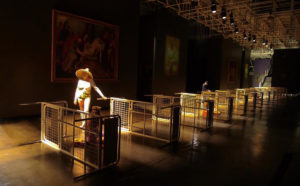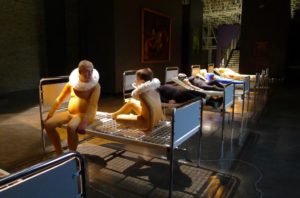In the philosophical-theological drama La Vida es Sueño Calderón de la Barca (1600-1681) staged human life understood as a process towards true knowledge, in a Platonic or Christian key, the transition from pure ferocity to rationality, the relationship between fate, providence and free will. In an imaginary Poland, King Basilio had his son Sigismund locked up in a tower to protect his people from the astrological prediction that he would become a bloodthirsty tyrant. The young man receives his only education on the outside world that he is denied by his guardian, until his father, repenting, decides to put him to sleep and transport him to court to test him and give him the chance to change his destiny. Exacerbated by imprisonment, Sigismondo behaves contemptuously so Basilio, having confirmed his evil nature, puts him back to sleep and has him taken back to prison. Destabilized by his own powerlessness, the prince can no longer distinguish the border between dream and reality and acquires the only certainty that will shape his future choices: all life is a dream.
Trying to frame La Vida es Sueño in a closed scheme is impossible, one gets the impression that his kaleidoscopic intertwining of plans gets out of hand, opening up to ever new levels of reflection. It is the triumph of the multiple Baroque that, masked by an apparent fairy-tale simplicity and by a title that seems to repropose a worn formula, underlies questions of universal importance: what is reality? Is the dream fiction and reality waking? What is freedom? If the life we live were only a representation in which we play a part? Almost 400 years later, human nature has not changed and these questions are very current even in our secular and confused society, which, compared to previous generations, has perhaps even less certainty to hold onto.
At the Monumental Complex of the Pilotta in Parma, as part of the three-year project The Imminent Past dedicated to Calderón de la Barca devised by Maria Federica Maestri and Francesco Pititto, Lenz Foundation reinterprets the Spanish drama in a contemporary key, making use of the bodies and voices of fifteen interpreters, including sensitive actors Paolo Maccini and Franck Berzieri, Sandra Soncini, historic protagonist of Lenz’s creations, performers over seventy as Giuseppina Cattani, Maria Giardino, Elena Nunziata, Mirella Pongolini, Cesare Quintavalla and Valeria Spocci and the children of the Association Ars Canto G. Verdi. The starting point of the script, which undermines the original narrative score in a polyphony of continuous metamorphoses, is the existential condition of Sigismondo at the mercy of his impulses and desires that clash with the imperturbability of a predestination of which he is unaware.
The setting, acording to Lenz’s constant attention to the key places in the city that are being revitalized revealing their discovered nerves, is the north wing of the National Gallery, in which large paintings on religious subjects of the seventeenth-century Italian tradition flutter like silent emanations of a disturbance that grows with the progression of the scenic action. The viewer is free to move around in the exhibition rooms left in the shadows and to discover the characters of the drama who are initially crouched and motionless in their dark niches. Then the music: insinuating, fragmented, persuasive, dissonant and painful.
Slowly these allegorical demons come to life and offer their disturbing physicality to the light: the soft and weak flesh, the talc-veiled wrinkles and the footprints that life has left in the bodies of the elderly are emphasized by visionary and ultra-contemporary props that interpret baroque opulence as shiny and synthetic colors. A cruel realism confronts these existential personifications with the nervous energy of children, who dart on the scene as dazzling metaphors of a here and now that does not admit procrastination.
From a tangle of blankets and chains emerges the Man just created by God from the mud, which in constant mirroring with his child-ego will have to overcome the temptations of the Prince of Darkness who offers him a Golden Pommel promising immortality. Acceptance becomes a solemn investiture, which instead of satisfying his yearning for fullness and happiness, throws him into the abyss of lack and disorientation, a prison-dream in which the four elements – earth, air, water, fire – collide to become storms, a boundless dreamlike limbo where clever children mock old fools and wisdom clashes with free will.
All the action is concentrated in a narrow corridor made syncopated by a sequence of reclining hospital beds: initially upside down on one side to create hybrid containment areas between the cell and the cradle, then in a normal position to accommodate on their cold grates the frightened bodies of the actors in dialogue with the Mourned on the dead Christ, the Depositions and the Annunciations in the paintings above. Residual places suspended between life and death in which the only space of possible freedom is in dream life, they present a catalog of fragility that Man observes and comments in an impartial soliloquy. His deeply empathic acting, in which the strong Emilian accent breaks down the barrier of the scenic artifice to directly reach the intimacy of the viewer, makes one perceive how the boundary between dream and real world has become (or has always been) subtle, almost interchangeable.
Together with him we become participants in the nakedness of the characters lying in search of an impossible pacification and we cannot help but project our anguishes for an unknowable future on them. There is no solution to the anxiety of controlling what happens to us in the time we have on Earth, if not that of entrusting ourselves to a sibylline Devotion which offers itself as an enigma because it is not what it seems and does not seem to be what it is, which isn’t dawn or sun, because it do not illuminate, laugh, nor cry.
Info:
La Vida es Sueño
Monumental Complex of the Pilotta in Parma
11 – 22 June h. 21.00 (break 16 and 17 June)
Admission: full € 18, reduced € 13 (under 30, over 60, students, DOC Card, YoungER Card, AUSL employees, Amici della Pilotta Association, employees of the Pilotta Monumental Complex, Associations, groups of 5 or more people), professional € 9.
For information and reservations: Lenz Teatro, Via Pasubio 3/e, Parma, tel. 0521 270141, 335 6096220, info@lenzfondazione.it – www.lenzfondazione.it.






For all images: La Vida es Sueño ph credits Francesco Pititto © Lenz Fondazione
Graduated in art history at DAMS in Bologna, city where she continued to live and work, she specialized in Siena with Enrico Crispolti. Curious and attentive to the becoming of the contemporary, she believes in the power of art to make life more interesting and she loves to explore its latest trends through dialogue with artists, curators and gallery owners. She considers writing a form of reasoning and analysis that reconstructs the connection between the artist’s creative path and the surrounding context.






NO COMMENT